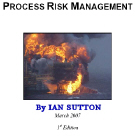Citations and References: Ian Suttonon
A complete list of citations and references for eBooks and Books by Ian Sutton.
Back to main page for author Ian Sutton.
Citations and References ...
This page provides citations and references for all the eBooks and books in Ian Sutton's operations, maintenance, and risk management series. Citations are listed by author.
Aluminum Association (The). Guidelines for handling molten aluminum. 1990.
American Institute of Chemical Engineers. Guidelines for the Management of Change of Process Safety. 1997.
American Petroleum Institute. API RP 14J. Recommended Practice for Design and Hazards Analysis for Offshore Production Facilities. 2001.
American Petroleum Institute, API RP 520. Sizing, Selection and Installation of Pressure Relieving Devices In Refineries. January 2000.
American Petroleum Institute, API RP 521. Guide for Pressure-Relieving and Depressuring Systems. 1997
ANSI. Occupational Health and Safety Management Systems. ANSI / AIHA Z10-2005, AIHA, Virginia, September 2005
B
Balasubramanian, S. G., J. F. Louvar. Study of major accidents and lessons learned. Process Safety Progress, 2004.
Baybutt, Paul. Major Hazards Analysis: An Improved Method for Process Hazards Analysis. Process Safety Progress. March 2003.
Bayer, Jim W. Keynote address. 3rd Annual Congress on Process Safety, Houston, April 23rd 2007.
Brander, Roy. The Titanic Disaster: An Enduring Example of Money Management vs. Risk Management. 1995.
Brander, Roy. The RMS Titanic and its Times: When Accountants Ruled the Waves. Elias Kline Memorial Lecture. 69th Shock & Vibration Symposium. 1998.
Brooks, Jr., F.P., "The Mythical Man-Month". New York: Addison-Wesley, 1995
C
Chemical Engineering Progress. Vacuum Hazards - Collapsed Tanks. February 2007.
Chemical Process Safety Report. April 1997.
Chicago Manual of Style. Chicago: University of Chicago Press. 1993.
Chopey, Nicholas P. Twelve Tips for Clearer Writing. Chemical Engineering. July 2003.
Crumpler, D.K. and D.K. Whittle. 'How to effectively revalidate PHAs'. Hydrocarbon Processing. October 1996
Chemical Hazards Response Information System. https://www.chrismanual.com. 2001.
Crawford, Neal and Dane Broussard. Winds of Change - How Katrina and Rita Have Affected "Business As Usual" in the Gulf of Mexico. Society of Petroleum Engineers, Gulf Coast Section. May 2007.
D
Davenport, J.A. History of the Loss Prevention Symposia: Forty Years, 1967-2006. Process Safety Progress, December 2006.
Department of Defense. Standard Practice for System Safety. MIL-STD-882D. 10 February 2000.
Diamond, Jared. Collapse. Penguin Books. 2006.
Dow's Fire & Explosion Index Hazard Classification Guide, 7th Edition. American Institute of Chemical Engineers (AIChE). June 1994.
Dow's Chemical Exposure Index Guide, 1st Edition American Institute of Chemical Engineers (AIChE). August 1998.
G
Giles, Douglas S., Peter N. Lodal. Case Histories of Pump Explosions while Running Isolated. Process Safety Progress. June 2001.
H
Hopkins, Anthony. Lessons from Longford.
Health & Safety Executive (UK). Control of major accident hazards (COMAH) 1999.
I
ISO 17776:2000(E). Petroleum and natural gas industries - Offshore production installations - Guidelines on tools and techniques for hazards risk assessment. First edition 2000-10-15.
ISO WD/3100. General Guidelines for Principles and Implementation of Risk Management, International Organization for Standards.
K
Kaplan Stanley and B. J. Garrick. 'On the Quantitative Definition of Risk'. Risk Analysis. 1981.
Khan, Faisal I. et al. 'Avoid the domino effect via proper risk assessment'. Chemical Engineering Progress. October 2000.
Kletz, T. Lessons from Disaster - How organisations have no memory and accidents recur. Institution of Chemical Engineers, 1993.
Kletz, T.A. Reliability Engineering and System Safety, 55 (3): 263, March 1997.
Kletz, T. A.. What Went Wrong: Case Histories of Process Plant Disasters. Gulf Publishing, Houston, Texas. 1998
Knowlton, R.E. A Manual Of Hazard & Operability Studies: The Creative Identification Of Deviations And Disturbances. Chemetics International Company Ltd. Vancouver, British Columbia. 1992.
Knowlton, R.E. An Introduction to Hazard and Operability Studies, The Guide Word Approach. February 1992.
L
Lapp, S.A. Applications of Fault Tree Analysis to Maintenance Interval Extension and Vulnerability Assessment. Process Safety Progress, June 2005.
Lawley, H.G., Chemical Engineering Progress, Vol. 70, No. 4, April 1974
M
MIL-STD 882D. 2000. Department of Defense. Standard Practice for System Safety.
Muhlbauer, W. Kent. Pipeline Risk Management Manual.3rd ed. 2003.
N
National Fire Protection Association. NFPA 496. Standard for Purged and Pressurized Enclosures for Electrical Equipment. 2003.
P
Pankoff, J.A. Training today's process plant operator. Hydrocarbon Processing. August 1999.
Pasquill, F. The estimation of the dispersion of windborne material. Meteorological Magazine. Vol. 90. No. 1063. 1961.
R
Reason, J. Managing the Risks of Organizational Accidents. Ashgate Publishing Company, 1997.
S
Sanders, Roy E. Chemical Process Safety: Learning from Case Histories. American Institute of Chemical Engineers.
Slovic, P. 'Perception of risk: reflections on the psychometric paradigm'. Social theories of risk, 95-108. 1992.
Smith, Andrew L. New Risk Management Standard for Delivering Superior Environmental and Safety Performance. Society of Petroleum Engineers (105503). 2007.
Strunk and White. The Elements of Style. 2000. Longman.
U
U.S. Department of Energy. Office of Nuclear Energy. Writer's Guide for Technical Procedures. September 1991.
V
Vesel, W.E. et al. Fault Tree Handbook. Office of Nuclear Regulatory Research. January 1981.
W
Wilson, Bill. Five-by-Five Whys. www.bill-wilson.net/b16.html. 2007.
Wright, Tim L. Still searching for Buncefield answers. Hydrocarbon Processing, September 2006.
Z
Zabetakis, M. G. (1965). Flammability characteristics of combustible gases and vapors. Bulletin 627, Bureau of Mines.
Please contact BIN95 with your questions and comments.






